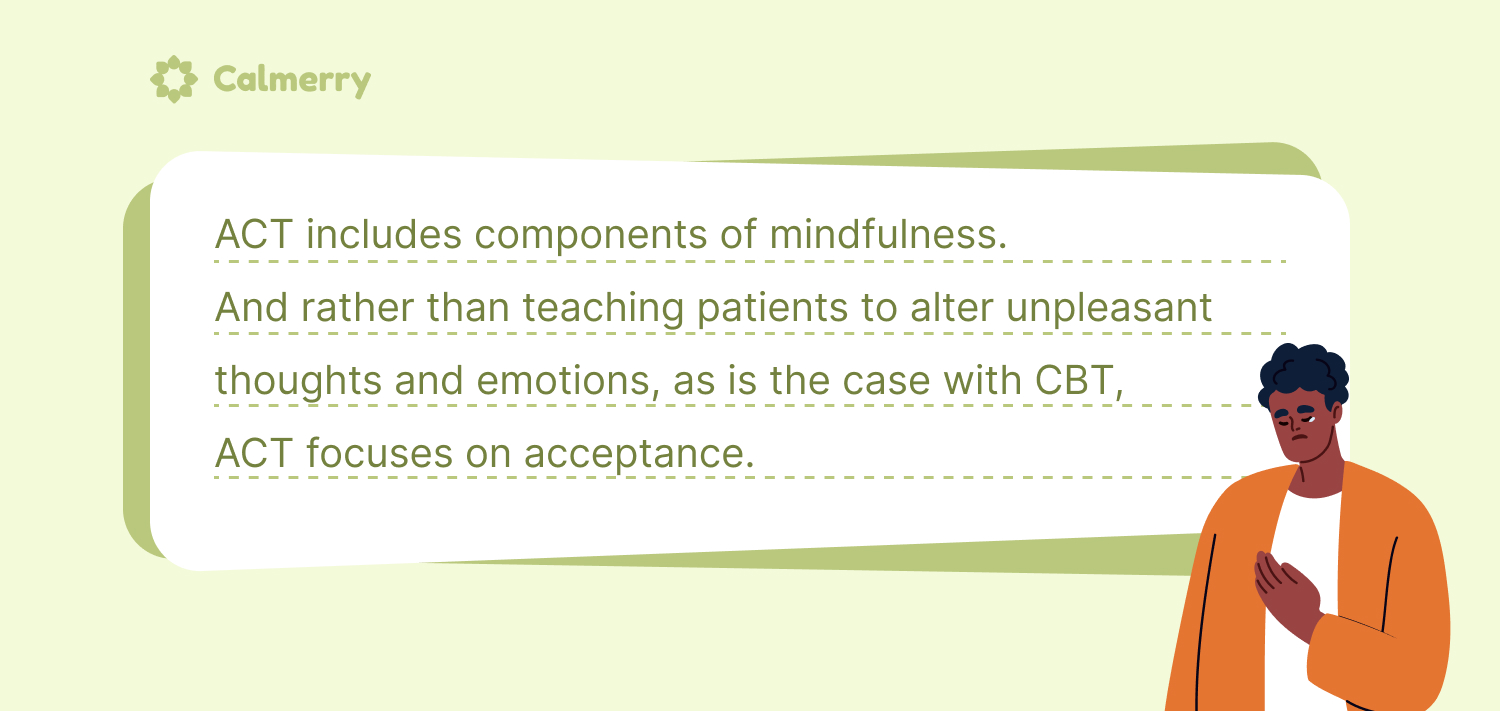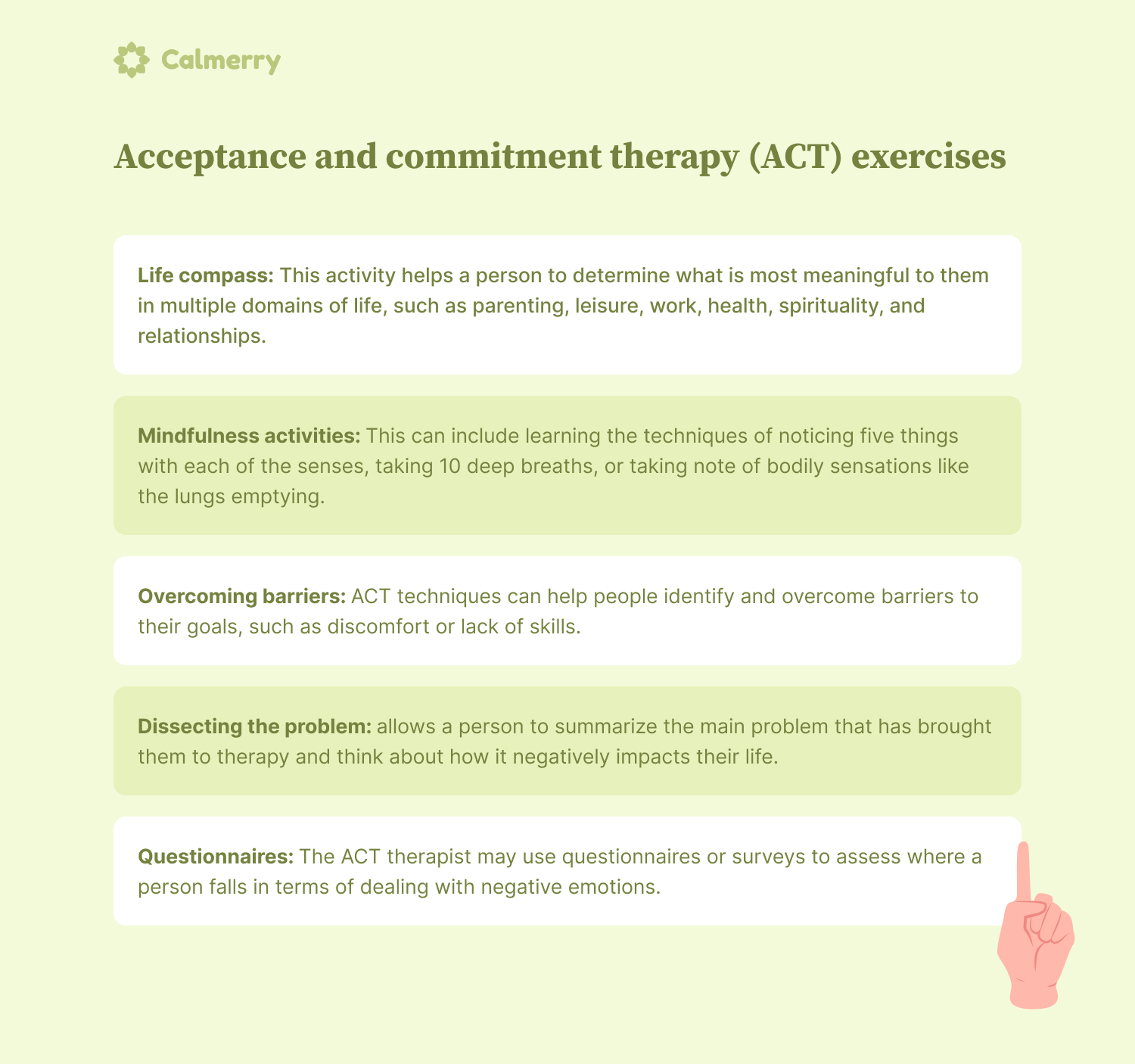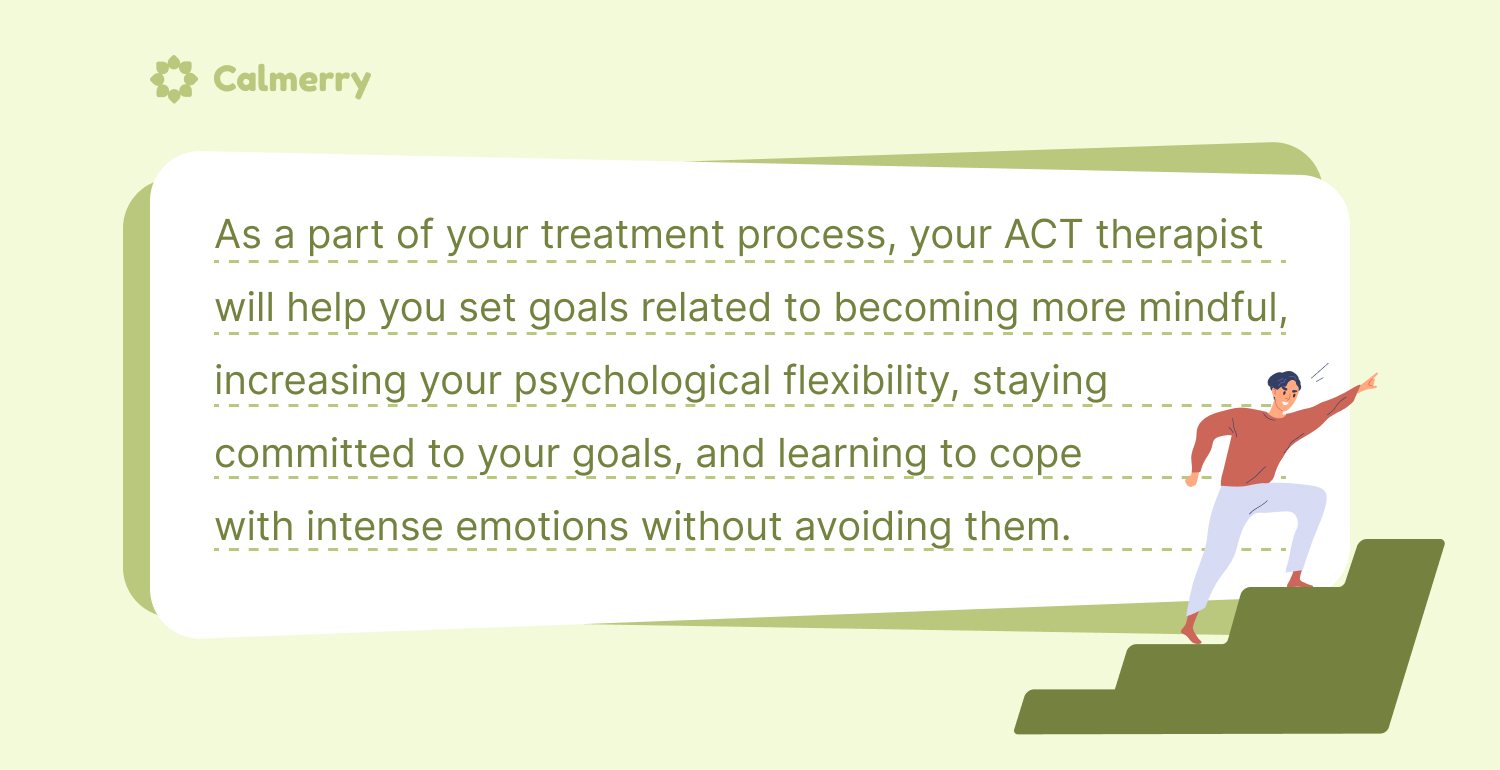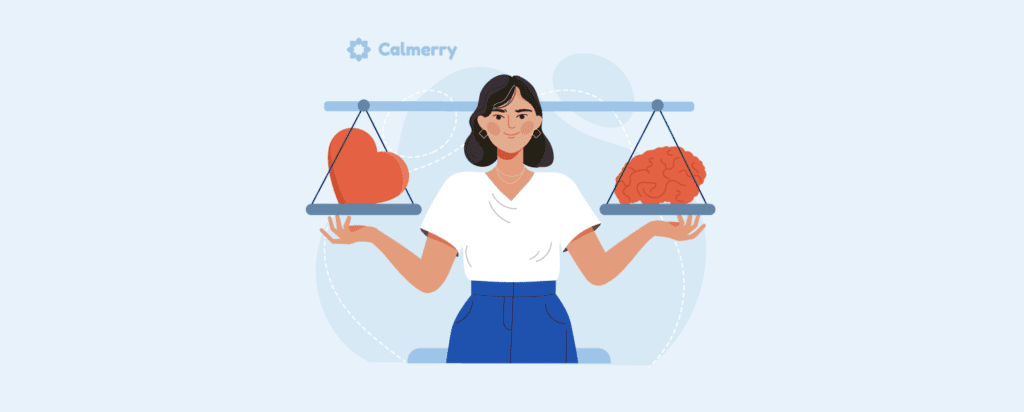What Is Acceptance and Commitment Therapy (ACT)? When It’s Used and What to Expect

In this article
When a person chooses to seek treatment for a mental health condition, there are a variety of options available. For instance, they might choose to see a doctor for medications to treat anxiety or depression, or they might see a counselor or therapist to “talk through” whatever emotions or problems are troubling them.
If you decide to seek the services of a counselor or therapist, it’s important to recognize that talk therapy is not “one size fits all.” In fact, there are a number of different therapeutic modalities that a mental health professional can use. Some clinicians may use multiple modalities, whereas others may have expertise in one particular approach.
One specific approach, called acceptance and commitment therapy (ACT), can be useful for treating numerous mental and emotional health problems. If you’re exploring different treatment options, it can be beneficial to learn more about ACT to determine if it’s a good fit for you.
What is acceptance and commitment therapy?
If you want to know if ACT is a suitable option for you, it’s helpful to understand the ins and outs of this method. Stephen C. Hayes is credited with the development of ACT, which some theorists consider an evolved form of cognitive behavioral therapy (CBT).

The ACT model recognizes that painful emotions, such as grief, sadness, disappointment, and anxiety, are a core component of human functioning, and rather than eliminating these emotional experiences, ACT seeks to help people live a life that aligns with their values and goals, even when faced with painful emotions.
How does ACT work?
ACT treatment involves learning how to pursue meaningful goals, such as developing relationships, establishing a career, and achieving personal growth. Furthermore, the model teaches people to avoid suppression of emotions, which the ACT therapist believes is linked to distress and dysfunction.
Ultimately, the goal of ACT is to teach a person to become more psychologically flexible and to pursue their life goals, even when life is challenging.
ACT vs. CBT
CBT and ACT are similar in the sense that ACT is considered a derivative of CBT, but the two are distinct treatment modalities.
- CBT is based on the belief that distorted thinking leads to psychological problems, and its goal is to change automatic thoughts. There is extensive research supporting the benefits of CBT for a range of psychiatric conditions.
- ACT, on the other hand, believes that problems arise when people avoid them and guides patients to notice and accept their problems. ACT includes components of mindfulness. And rather than teaching patients to alter unpleasant thoughts and emotions, as is the case with CBT, ACT focuses on acceptance.
ACT vs. DBT
Like ACT, DBT focuses on mindful behavior. In sessions with a DBT therapist, patients learn skills required for emotional regulation, interpersonal effectiveness, and distress tolerance.
DBT and ACT have not been researched as extensively as CBT, but there are studies confirming their effectiveness.
ACT has been studied with a wider range of populations when compared to DBT. While its use is expanding, DBT was primarily developed to treat borderline personality disorder (BPD), substance use disorder, and trauma.
What is ACT used for?
So, what is ACT therapy used for? It turns out that there are multiple uses of this treatment modality. Mental health experts have described ACT as being beneficial for treating the following conditions:
- Mood disorders (depression, bipolar disorder)
- Substance use disorders
- PTSD and trauma-related symptoms arising from a history of sexual assault or child abuse
- Psychotic disorders like schizophrenia
- Phobias
- Obsessive-compulsive disorder
- Relationship problems
- Anxiety
Is it effective?
People interested in acceptance and commitment therapy often wonder if this treatment modality is effective. Fortunately, extensive research has been conducted with this model, and the results have been promising.
Research with ACT for treating substance use disorders has shown that this modality is beneficial for reducing substance use. It is also associated with complete cessation of substance use and long-term abstinence.
Studies evaluating ACT for anxiety and obsessive-compulsive disorder (OCD) have also revealed positive outcomes. For example, a review of multiple studies concluded that ACT is just as effective as cognitive behavioral therapy (CBT) for treating symptoms of anxiety and OCD.
Finally, studies involving individuals experiencing symptoms of both psychosis and trauma have found ACT to be beneficial. More specifically, ACT can reduce symptom severity and help patients to develop stronger skills for accepting and regulating their emotions.
ACT techniques and exercises

An ACT therapist uses specific techniques and exercises that align with the ACT model. ACT exercises are based on the following core principles:
- Achieving a state of psychological flexibility
- Learning mindfulness skills to remain in the present, even when experiencing stress
- Teaching balance so that painful emotions do not lead to unhealthy avoidance behaviors
- Developing meaningful goals and focusing on hope and personal values
- Learning to behave in a way that aligns with one’s goals, hopes, and values
- Accepting the feelings that arise when engaging in difficult tasks that bring one closer to their goals
- Learning defusion, which is the ability to separate oneself from thoughts that interfere with goals
Specific acceptance and commitment therapy techniques can be utilized to achieve the above aims. For instance, the exercise of “dissecting the problem” allows a patient to summarize the main problem that has brought them to therapy and think about how it negatively impacts their life.
This exercise also challenges a patient to think about what emotions they struggle with related to the problem and what people or situations they’re avoiding because of it.
Sometimes our self-esteem, self-worth, and mood struggles are linked to engaging in behaviors not aligned with our values. With the help of this worksheet, claryfying and defining your values your values will help you ensure that you act according to what truly matters to you.
Other ACT exercises include:
- Life compass: This activity helps a person to determine what is most meaningful to them in multiple domains of life, such as parenting, leisure, work, health, spirituality, and relationships.
- Mindfulness activities: This can include learning the techniques of noticing five things with each of the senses, taking ten deep breaths, or taking note of bodily sensations like the lungs emptying.
- Overcoming barriers: ACT techniques can help patients identify and overcome barriers to their goals, such as discomfort or lack of skills.
- Questionnaires: The ACT therapist may use questionnaires or surveys to assess where a patient falls in terms of dealing with negative emotions.
Acceptance and commitment therapy worksheets can also be helpful tools. A therapist may assign these worksheets as “homework” to help a patient practice skills between sessions, or homework exercises may be discussed as a component of treatment.
What to expect in the first therapy session
When you enter ACT treatment, your first session begins with a full assessment, during which the therapist gathers information about why you’re seeking therapy.
They will conduct a comprehensive assessment, which includes gathering information about the following:
- Your mental health history
- Your current functioning
- The symptoms or problems that brought you to therapy
- And your family dynamics
After completing an assessment, your therapist will work with you to develop treatment goals. Based on the philosophy that underlies ACT, the assessment process will likely involve taking a look at how your current thought processes and behavioral patterns may be interfering with your life goals and values.
As a part of your treatment process, your ACT therapist will help you set goals related to becoming more mindful, increasing your psychological flexibility, staying committed to your goals, and learning to cope with intense emotions without avoiding them.

What to look for in an ACT therapist
If you think ACT is a good fit for you, it’s important to find a qualified therapist with experience and/or training in this modality. They should be a licensed mental health professional, such as a social worker, psychologist, or professional counselor.
Your therapist should also treat you with dignity and respect and make you feel accepted.
Finding a therapist who is a good fit for you can be one of the most important parts of treatment. If you aren’t comfortable with your ACT therapist, this is a sign that this professional probably isn’t the right fit for your needs.
Get started with Calmerry
At Calmerry, we employ licensed, compassionate therapists trained and experienced in the ACT approach. They are prepared to work with you virtually to address a range of psychological and emotional problems – via text, video, or both.
We can match you with the best-suited professional to your unique needs within 1 hour. To help you find a good for you, we offer free therapist switching.
Please note that our platform may not be suitable for people who need treatment for substance use disorders and psychotic disorders. Visit our webpage to learn more about online talk therapy services.
FAQs
The answers to the following common questions provide additional information about the ACT model.
What is the goal of acceptance and commitment therapy?
The ultimate goal of ACT is to help patients become more psychologically flexible and comfortable living with uncomfortable or painful emotions.
This is achieved through teaching mindfulness skills, identifying goals and values, and helping people to stay committed to achieving their goals.
What are the potential drawbacks of ACT?
No therapeutic model is perfect, and this is true for ACT. One potential drawback of this modality is that despite research supporting its benefits, ACT is not as well-studied as more common models like CBT. Some patients may prefer a gold-standard treatment like CBT over ACT.
Another potential limitation of ACT is that it does not address underlying thinking patterns or core beliefs that could contribute to a patient’s distress.
What are the benefits of ACT?
ACT has demonstrated effectiveness in multiple studies, and it can be used to treat a variety of psychological and emotional conditions, including depression, anxiety, substance use disorder, trauma, and psychosis.
ACT therapists aim to be empowering and accepting. And they can help patients to become more comfortable with confronting their problems and living with painful emotions.
online therapy
live video session





